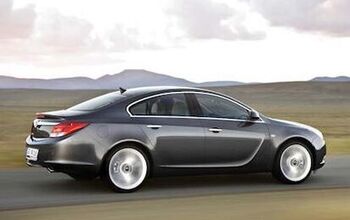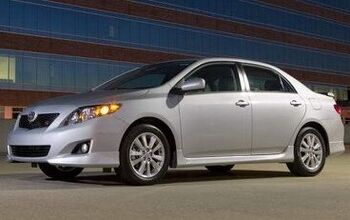Ford Fondly Remembers Cash for Clunkers

With social distancing measures throwing automotive sales straight into the dumpster, Ford is reportedly getting ready to float some interesting ideas by the U.S. government. It’s vying for a stimulus deal aimed at giving the industry a jump start after the health crisis posed by the novel coronavirus subsides.
One of the models Ford’s pushing is unsettlingly familiar.
According to Bloomberg, Mark LaNeve — Ford’s vice president of U.S. marketing, sales and service — is fondly reminiscing about Cash for Clunkers and thinks it’d be a great way to bolster auto sales after COVID-19 takes a hike.
“We think some level of stimulus somewhere on the other side of this would help not only the auto industry and our dealers, which are a huge part of our overall economy, but will help the customers as well,” LaNeve explained to the outlet over the phone. “We’re in discussions about what would be the most appropriate.”
From Bloomberg:
Those discussions are internal at Ford for now, but are eventually expected to involve the federal government, LaNeve said a day after automakers reported their slowest monthly pace of U.S. sales in a decade. One model being considered is the 2009 “cash for clunkers” program that helped stimulate auto sales following the global financial crisis by encouraging drivers to turn in an older car in exchange for thousands of dollars toward buying a new one.
“Cash for clunkers was very effective at that time,” LaNeve said. “It would be nice to think we could have something equally as effective for 2020 when we get out of this because it was a great program.”
Let’s reexamine the recession-era Car Allowance Rebate System (aka Cash for Clunkers) the government enacted in 2009 to see if LaNeve has his lid on straight. The system was intended to provide economic incentives (money vouchers valued between $2,500 and $4,500) to encourage U.S. residents to purchase new vehicles with greater fuel economy amid the Great Recession, provided they had something older to trade in. But stimulating a weak economy was only half the equation; the Obama administration also hoped it would reduce pollution and put more Americans into safer cars.
In terms of participation, the program was a success. Within a month of being introduced the appropriated funds were exhausted, forcing Congress to approve an additional $2 billion (bringing the grand total to $3 billion). That first month saw a significant increase in auto sales (mostly for Japanese brands). While there are conflicting studies regarding what happened afterward, sales were noticeably down in the proceeding months. A study published in the Quarterly Journal of Economics in 2012 framed it as a wash, saying “the effect of the program on auto purchases is almost completely reversed by as early as March 2010 — only seven months after the program ended.”
Subsequent studies backing up those claims, few of which bother dive into the high number of used vehicles that were destroyed or failed to become charitable donations to local organizations. Depending upon who crunched the numbers, Cash for Clunkers was either economically neutral or resulted in short term gains that ultimately resulted in a net loss. The popular public presumption embraces the latter scenario and echo countless articles written after 2009. Those that came before tend to have a comparatively optimistic opinion of the scheme.
From an environmental standpoint, the program seems to have worked slightly better. Most studies peg Cash for Clunkers as reducing anywhere from 5 to 30 million tons of carbon emissions from vehicle tailpipes. That’s quite the spread, however, and most experts agree that the recession, in addition to abnormally high fuel prices, was already pushing consumers into smaller automobiles with superior fuel economy. The Car Allowance Rebate System was unlikely to be the contributing factor here, with even its advocates suggesting the environmental improvements were minimal and costly.
With the above in mind, we are hoping Ford has other ideas it’s willing to float by the federal government — because a re-do of Cash for Clunkers seems undesirable when viewed broadly. It’s understandable why the company would be interested in a stimulus deal of some kind. Ford reported a 12-percent decline in first quarter U.S. deliveries on Thursday. With its core rivals undoubtedly enduring similar losses, we expect other automakers to embrace whatever help the government can offer.
[Image: Paul Brennan/Shutterstock]

A staunch consumer advocate tracking industry trends and regulation. Before joining TTAC, Matt spent a decade working for marketing and research firms based in NYC. Clients included several of the world’s largest automakers, global tire brands, and aftermarket part suppliers. Dissatisfied with the corporate world and resentful of having to wear suits everyday, he pivoted to writing about cars. Since then, that man has become an ardent supporter of the right-to-repair movement, been interviewed on the auto industry by national radio broadcasts, driven more rental cars than anyone ever should, participated in amateur rallying events, and received the requisite minimum training as sanctioned by the SCCA. Handy with a wrench, Matt grew up surrounded by Detroit auto workers and managed to get a pizza delivery job before he was legally eligible. He later found himself driving box trucks through Manhattan, guaranteeing future sympathy for actual truckers. He continues to conduct research pertaining to the automotive sector as an independent contractor and has since moved back to his native Michigan, closer to where the cars are born. A contrarian, Matt claims to prefer understeer — stating that front and all-wheel drive vehicles cater best to his driving style.
More by Matt Posky
Latest Car Reviews
Read moreLatest Product Reviews
Read moreRecent Comments
- Joe65688619 Under Ghosn they went through the same short-term bottom-line thinking that GM did in the 80s/90s, and they have not recovered say, to their heyday in the 50s and 60s in terms of market share and innovation. Poor design decisions (a CVT in their front-wheel drive "4-Door Sports Car", model overlap in a poorly performing segment (they never needed the Altima AND the Maxima...what they needed was one vehicle with different drivetrain, including hybrid, to compete with the Accord/Camry, and decontenting their vehicles: My 2012 QX56 (I know, not a Nissan, but the same holds for the Armada) had power rear windows in the cargo area that could vent, a glass hatch on the back door that could be opened separate from the whole liftgate (in such a tall vehicle, kinda essential if you have it in a garage and want to load the trunk without having to open the garage door to make room for the lift gate), a nice driver's side folding armrest, and a few other quality-of-life details absent from my 2018 QX80. In a competitive market this attention to detai is can be the differentiator that sell cars. Now they are caught in the middle of the market, competing more with Hyundai and Kia and selling discounted vehicles near the same price points, but losing money on them. They invested also invested a lot in niche platforms. The Leaf was one of the first full EVs, but never really evolved. They misjudged the market - luxury EVs are selling, small budget models not so much. Variable compression engines offering little in terms of real-world power or tech, let a lot of complexity that is leading to higher failure rates. Aside from the Z and GT-R (low volume models), not much forced induction (whether your a fan or not, look at what Honda did with the CR-V and Acura RDX - same chassis, slap a turbo on it, make it nicer inside, and now you can sell it as a semi-premium brand with higher markup). That said, I do believe they retain the technical and engineering capability to do far better. About time management realized they need to make smarter investments and understand their markets better.
- Kwik_Shift_Pro4X Off-road fluff on vehicles that should not be off road needs to die.
- Kwik_Shift_Pro4X Saw this posted on social media; “Just bought a 2023 Tundra with the 14" screen. Let my son borrow it for the afternoon, he connected his phone to listen to his iTunes.The next day my insurance company raised my rates and added my son to my policy. The email said that a private company showed that my son drove the vehicle. He already had his own vehicle that he was insuring.My insurance company demanded he give all his insurance info and some private info for proof. He declined for privacy reasons and my insurance cancelled my policy.These new vehicles with their tech are on condition that we give up our privacy to enter their world. It's not worth it people.”
- TheEndlessEnigma Poor planning here, dropping a Vinfast dealer in Pensacola FL is just not going to work. I love Pensacola and that part of the Gulf Coast, but that area is by no means an EV adoption demographic.
- Keith Most of the stanced VAGS with roof racks are nuisance drivers in my area. Very likely this one's been driven hard. And that silly roof rack is extra $'s, likely at full retail lol. Reminds me of the guys back in the late 20th century would put in their ads that the installed aftermarket stereo would be a negotiated extra. Were they going to go find and reinstall that old Delco if you didn't want the Kraco/Jenson set up they hacked in?


































Comments
Join the conversation
Don't confuse us with facts, there's baseless and ill-informed outrage to indulge!
This time around, a lot of the clunkers off my head are: 1. Nissan with CVT problems 2. Hyundai with engine problems 3. Honda with auto transmission problems 4. European with all sort of reliability problems 5. GM with lower intake manifold problems etc etc Those middle age cars with reliability problems, we will get rid of them. Those nuclear war proof little cars will live.